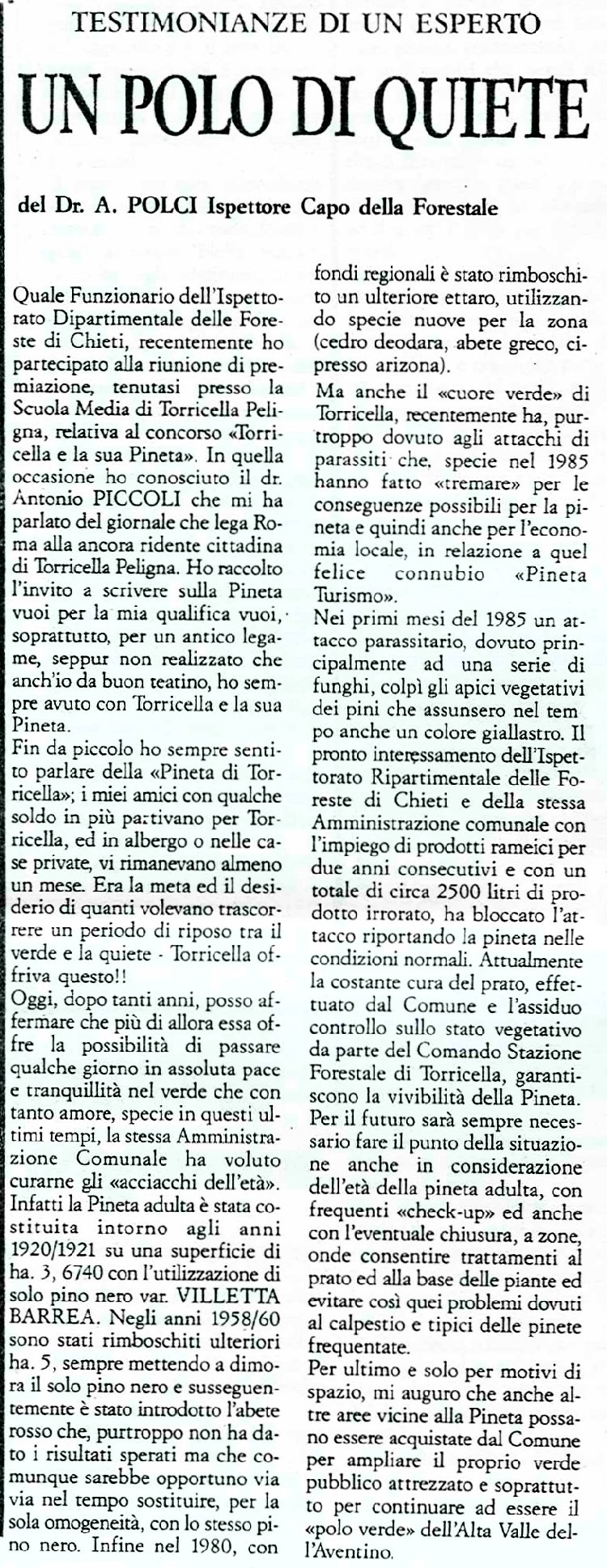|
 |
Testimony of an Expert
A Park Full of Tranquillity
By Dr. A. Polci, Chief Forestry Inspector
As an Officer of the Department of Forestry Inspectors of Chieti, I
recently took part in the prize-giving meeting held at the Middle
School in Torricella Peligna, associated with the competition entitled
“Torricella and its Pinewood”. There I met Dr. Antonio Piccoli, who
told me about the journal that links Rome to the still charming
village of Torricella Peligna. I took up his invitation to write about
the Pinewood, both because of my qualifications and above all for an
ancient bond that, even as a good Teatino[1], I have always
felt for Torricella and its Pinewood.
Ever since I was very small I had always heard mention of the
“Pinewood of Torricella”; some of my more wealthy friends used to
leave for Torricella where they would stay in a hotel or private
accommodation for at least a month. It was the goal and the desire of
anyone who wanted to spend a peaceful period of rest amongst the
greenery – which Torricella offered!
Now, after many years, I can confirm that even more than in those
days, it offers us the chance to spend several days in absolute peace
and tranquillity amidst the green that with so much love, especially
in recent times, the Administrators of the Commune have dedicated to
looking after its “ailments of old-age”. In fact the adult Pinewood
was formed around 1920-1921 in an area of 3,6740 hectares using black
pine of the variety Villetta Barrea[2]. Between 1958-1960,
a further 5 hectares were reafforested still only using the black pine
but subsequently the red fir was introduced although unfortunately it
did not give the hoped for results; it would be best over time to
substitute this type too with black pine for homogeneity. Finally in
1980,with funding from the Region, another hectare was reforested
using species new to this zone (Deodar Cedar, Cephalonian or Greek Fir
(a black pine), Arizona Cypress).
Even the “green heart” of Torricella unfortunately has suffered
recently from attack by parasites which especially in 1985 caused us
to “quake” in fear of the possible consequences for the Pinewood and
also for the local economy, in relation to this happy union of
“Pinewood Tourism”.
Early in 1985 parasitic disease due principally to a series of fungi,
attacked the vegetative apices of the pines, which became yellow-coloured
with time. Prompt action by the Department of Forest Inspectors of
Chieti and the Commune’s own Administration, using a total of 2,500
litres of cupric[3] product spray for two consecutive years
blocked the attack and the pine trees returned to normal. Currently
constant care of the meadowland, carried out by the Commune and
assiduous control of the state of the vegetation by the Forestry
Command Station of Torricella, are ensuring the viability of the
Pinewood.
In the future it will always be necessary to keep abreast of any
situation that arises, especially in view of the age of the mature
pine forest, with frequent check-ups and even possibly closure on a
zone by zone basis, to allow for any necessary treatments to the
meadows and to the bases of the trees, in order to avoid problems due
to trampling, typical of much-visited pine forests.
Finally and only for reasons of space, I hope that the Commune will be
able to purchase further areas adjacent to the Pinewood so that it can
increase its own areas of equipped public greenery especially so that
it can continue to be the “Park of Tranquillity” of the upper valley
of the Aventino. |
TRANSLATOR’S NOTES:
[1] Teatino = the same as Chietino = someone who comes form Chieti;
Chieti is a town in Abruzzo, capital of the Province of Chieti; Chieti
lies on a crest along the Pescara river and has an unmistakable
profile with the high bell-tower of San Giustino set against the
skyline; it is a few km away from the Adriatic Sea, and has the
Majella and Gran Sasso in the background. In Roman times the town was
called Teate, and later it became an important medieval centre.
The Province of Chieti is a hilly, mountainous area between the
Adriatic sea to the east and the Maiella chain to the north-west. It
is extensively cultivated with olive trees and vineyards, and produces
celebrated wines and extra-virgin olive oil. The province of Chieti
was called "Citeriore" since it was situated to the right of the
Pescara river and was in Latin "citra" (=this side) with reference to
Naples, the capital of the Kingdom. The Pescara river separated it
from the province of Teramo, the Apennine Mountains from the province
of L'Aquila, the right shore of the Sangro and the Valicella of the
Varrino from Molise. The territory includes mountainous features, the
group of the Maiella, and 72 km of steep and rocky coast, along the
Adriatic sea.
Torricella Peligna is a village situated in the Province of Chieti,
Abruzzo.
[2] Pino nero di Villetta Barrea – Found especially in the Abruzzo
National Park; it is distinguishable by the dark colour of its
tuft-like foliage; it has short paired pine needles that are shorter
than those of other black pine species (5-10 cm); it is used in the
paper industry to produce cellulose.
See “The Essential Trees in the Pinewood”
by Antonio Piccoli
[3] cupric products – various copper compounds have been used for
centuries as fungicides to treat plant diseases - see
"Copper.org"
Translation courtesy of
Dr. Marion Apley Porreca
|
© Amici di Torricella No
0 1988? page 1 |
|
